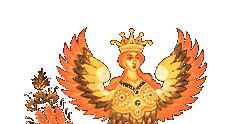In Russian folklore there are many stories of Baba Yaga, the fearsome witch. Hideous to look upon, and with a nature to match, she devours her victims with her iron teeth.
In some stories her back is so bent down from age that she touches the ground with her head. Her nose is so long that it reaches the ceiling of her Hut on Chicken's Legs when she is sleeping. She sleeps stretched out on her ancient brick oven, which she also uses to cook her meals (including people whom she catches).
She does not seem to bother with pointed witch's hats, and has never been seen sitting on a broomstick. Her mode of travel is a large mortar pushed along with a pestle. Never one for leaving a trail behind her, she sweeps away all traces of her path with a broom.
It is also rumoured that she can fly through the air in the same manner.
She lives in a hut in the forest. The hut seems to have a personality of its own and can move about at will on its large-sized chicken legs, that's why it's called Hut on Chicken's Legs. Usually the hut is either spinning around as it moves through the forest or standing with its back towards a visitor and when approached, will only permit entry after a certain secret incantation is said: "Hut, hut, turn your back to the forest and your front to me". It spins around with blood-curdling wild screeches and creakings and eventually comes to a stop to face the visitor, where it will lower itself down on its chicken legs and throw open its door. Its windows are sometimes described as its "eyes".
The hut is surrounded by a fence made of the bones of Baba Yaga's victims. Baba Yaga scares passersby to death just by appearing to them and then devours them. Her fence is topped with the skulls of her victims whose blazing eye sockets illuminate the darkness.
In some stories she has two older sisters, who are also called Baba Yaga, just to confuse you!
Although she is mostly portrayed as a terrifying old crone, she can also play the role of a helper and wise woman. Like all forces of nature, though often wild and untamed, she can also be kind. She sometimes gives advice and magical gifts to heroes with pure hearts. The hero or heroine of the story often enters the crone's domain searching for wisdom, knowledge and truth. Then there's also an incantation to be said to Baba Yaga. When she begins asking questions, the hero must say: "Hey you old woman, first you satisfy my hunger then you satisfy my thirst then let me wash myself in your banya (sauna) then let me sleep in and then you ask me anything". Usually Baba Yaga does as the hero pleads her.
She is said to be a guardian spirit of the fountain of the Waters of Life and of Death.
Baba Yaga rules over the elements and her realm is the birch forests of old Russia.
Her faithful servants are the White Horseman, the Red Horseman and the Black Horseman. When Vasilissa the Beautiful (sometimes called Vasilisa the Wise) asks her who these mysterious horsemen are she replies: "My Bright Dawn, my Red Sun and my Dark Midnight."
Among her other servants whom she calls "my soul friends" and whom she is reluctant to discuss with visitors are the three bodiless pairs of hands, which appear out of thin air to do her bidding.
Baba Yaga is the arch-crone, the goddess of wisdom and death, the bone mother. She brings wisdom and death (just like wild nature does) and through death, rebirth. Behind her story is the figure of the ancient Slavic goddess of death and rebirth, whose autumn harvest holds the promise of winter survival and new growth in Spring.
The "old woman" of autumn was called Baba by the Slavic inhabitants of eastern Europe.
Baba passed into Slavic folk legend as Baba Yaga.
|



